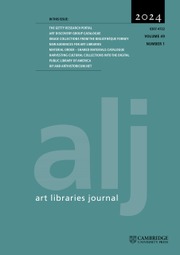No CrossRef data available.
Article contents
Standardization at Babel - Iconclass at the next level: a laboratory for image research
Published online by Cambridge University Press: 07 November 2024
Abstract
The Iconclass browser has often been used as a standard in AI projects, but has not been used to the same extent to standardise metadata in heritage institutions. Yet with the increasing proliferation of AI, metadata standardisation is imperative. This article provides insight into the new version of the Iconclass browser and explains some common misconceptions about the tool. It makes the case for standardisation of metadata and the potential use of the Iconclass browser toward that goal.
- Type
- Research Article
- Information
- Copyright
- Copyright © The Author(s), 2024. Published by Cambridge University Press on behalf of ARLIS
References
1. Quoted from the King James version of Genesis 11:1–9.
2. See: https://iconclass.org (the online version is developed and maintained by E. Posthumus and edited by the author).
3. For an example of a JSON version of an Iconclass concept see: https://iconclass.org/51M11.json. Typing .JSON after any Iconclass URL will retrieve its JSON version, allowing the inspection of its BoW.
4. I have used ChatGPT 3.5 in March 2024. ChatGPT is quite verbose. I am quoting a literal but condensed version of its answers.
5. Wolkenhauer, Anja, Zu schwer für Apoll. Die Antike in humanistischen Druckerzeichen des 16. Jahrhunderts, (Wiesbaden: Harrassowith Verlag, 2002), 169Google Scholar: “Der Text wird dem Signet niemals beigefügt”. Professor Wolkenhauer's observations are identical to my own.
6. The answer ignores the oxymoron aspect by not mentioning the details symbolizing the opposites.
7. Slightly belying the ‘Open’ in the company's name… An additional reason for not sharing its training data may be that it is unclear how much of it was protected by publishers' copyrights, or by Creative Commons' ‘share alike’ licenses.
8. Giovio, Paolo, Dialogo dell'imprese militari et amorose (Lyon, 1574)Google Scholar, contains two imprese with this motto. One shows a crab and a butterfly and the other a dolphin and anchor.
9. Possibly the ‘galloping horse’ refers to an emblem by Dirck Pietersz Pers, where it symbolizes freedom rather than speed. See: Pers, Dirck Pietersz, Bellerophon of Lust tot Wijsheid (Amsterdam, 1614)Google Scholar, emblem 101 with the motto ‘Libertas inestimabilis res est'.
10. An emblem by Otto van Veen showing the four ages of man, carries this motto: Otho Vaenius, Emblemata Horatiana (Antwerp, 1612), emblem 100.
11. David Cramer used this motto for an emblem showing a weaver: David Cramer, Octoginta emblemata nova (Frankfurt, 1630), emblem 66.
12. I am deliberately ignoring ‘analogue’ sources that are digitized and offered online in violation of copyrights.
13. The online edition referenced is at: https://adagia.resources.huygens.knaw.nl/
14. The first plans to computerize the Iconclass system were called “Global analysis of an Iconographic Bibliography System”. F. v.d. Walle, P.L.W. Aerts, Memo 4-71-31: Globale analyse Iconografisch Bibliografie Systeem. Typescript (Amsterdam, Infonet, 1971).
Full text available at: https://iconclass.org/read/1971_Infonet_Analyse.pdf
16. See for example: N. Banari, W. Daelemans and M. Kestemont, Multi-modal Label Retrieval for the Visual Arts: The Case of Iconclass. In: Proceedings of the 13th International Conference on Agents and Artificial Intelligence (ICAART 2021) - Volume 1, pages 622–629.
17. J.P.J. Brandhorst, Meaningful patterns. Can a mix of pattern matching and computer-assisted classification produce a paradigm shift in iconography? In: C. Fabian (ed.), Bibliothek und Wissenschaft 55: Faszination (Buch-)Handschriften im Jahr 2022, (Wiesbaden: Harrassowitz Verlag, 2022) 289
18. Circa 2,500 concepts were added or edited since the Browser went online.
19. Panofsky, Erwin, Studies in Iconology, Humanistic Themes in the Art of the Renaissance (Oxford: Oxofrd University Press, 1939), 3–32Google Scholar.
20. J.P.J. Brandhorst, Meaningful patterns, (op. cit. n. 16) p. 288. See also: Gengnagel, T., Digital Scholarly Editions Beyond Text. Modellling Art, Film and Everything in Between (Heidelberg: arthistoricum.net, 2024) 264Google Scholar.
21. H. van de Waal, In Memoriam Erwin Panofsky. Mededelingen der Koninklijke Nederlandse Akademie van Wetenschappen. Nieuwe reeks - deel 35 - No. 8, (1972) p. 9: “One might even say that Panofsky was not at his best the few times he attempted to force his craft into a system.”


